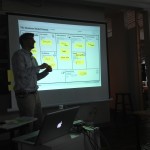Jan12
GameChanger: Open Innovation through Angel Investing
Point: Create an internal venture fund to incubate revolutionary ideas.
Story: This week’s Innovation Summit at the Shell Technology Center Houston (STCH) highlighted the need for innovation and collaboration to solve society’s most pressing challenges. As the world’s problems become more complex, the best way to tackle them is with a cross-disciplinary approach.
What are some ways that companies can foster this multidisciplinary collaboration to achieve breakthrough innovation? One way is to create an open mechanism inside the company that solicits promising ideas regardless of where they come from — including outside the company — and offering seed funding that’s outside of the company’s traditional R&D programs to give them time to develop.
GameChanger
Shell is doing this with its GameChanger program, headed by Russ Conser. GameChanger seeks out  and invests in early-stage ideas that could potentially revolutionize the energy industry. GameChanger plays the role of an angel investor; a panel screens ideas and selects ones to fund. Idea submissions can come from any Shell employee as well as from outside the company.
and invests in early-stage ideas that could potentially revolutionize the energy industry. GameChanger plays the role of an angel investor; a panel screens ideas and selects ones to fund. Idea submissions can come from any Shell employee as well as from outside the company.
Shell actively solicits ideas from academics and entrepreneurs alike through its web site www.shell.com/GameChanger. Ideas that pass the initial screen receive seed money — $25,000 to develop a robust proposal and on up to $500,000- $1 million a year to actually test and develop ideas that graduate into projects.
Example
For example, Erik Cornelissen, a research scientist, was in a toy store looking for a gift for his nephews when he saw a science toy that many of us have seen before: a dinosaur that grows in size when placed in water. A nifty, fun gift. But Erik made a connection back to a perplexing problem that had plagued Shell and other oil companies for a long time. Specifically, oil wells contain water, not just oil. Over time, more and more water gets pumped up relative to oil. Not only does that make the well less productive, but it pumps water that increasingly is becoming a scarce resource itself. The question is, how to detect that water and prevent it from mixing with the oil?
Erik realized that the same principle behind the dinosaur toy — a material that expands upon contact with water — could be applied at the oil well. Erik needed to identify a “swellable elastomer” that would seal off the pipe when water started to mix with the oil flowing through it. The idea was not difficult to articulate or explain, but finding this kind of material proved long and difficult. GameChanger provided Erik with the time and funding he needed to go through hundreds of experiments to find the elastomer that fit the demanding conditions at the oil well site.
Results
About 40% of Shell’s core Exploration & Development R&D portfolio has evolved from ideas submitted  to GameChanger, and 70% of the GameChanger portfolio includes collaboration with people outside of Shell.
to GameChanger, and 70% of the GameChanger portfolio includes collaboration with people outside of Shell.
Since its inception in 1996, GameChanger has funded 3000 ideas, investing $350 million and resulting in 250 commercial projects, said Gerald Schotman, EVP, Innovation, R&D and Chief Technology Officer at Shell.
Action
• Publicize clear and explicit selection criteria, so external submitters know what you want and will fund. For example, GameChanger uses 3 primary criteria:
- Novelty: is the idea truly and fundamentally new and different? (There’s no point in funding ideas that would qualify as traditional R&D projects.)
- Value: Could the idea create substantial new value if it works? (Wild ideas are welcome, but ultimately they need to deliver value if they come to fruition.)
- Credible Plan: is there a plan to manage risks prudently? (New ideas are risky, but many risks can be identified up front and plans can be put in place to stay ahead of them.)
• Have an end game for how you’ll commercialize an idea that demonstrates feasibility. For example, GameChanger uses 3 commercialization strategies:
- Move the idea into the company’s internal R&D portfolio.
- License the idea externally.
- Spin off a new company to bring the idea to market.
Comments Off on GameChanger: Open Innovation through Angel InvestingCapital, Case study, Entrepreneurs, Growth, How-to, Innovation, New Product Development, open innovation, R&D, Strategy












